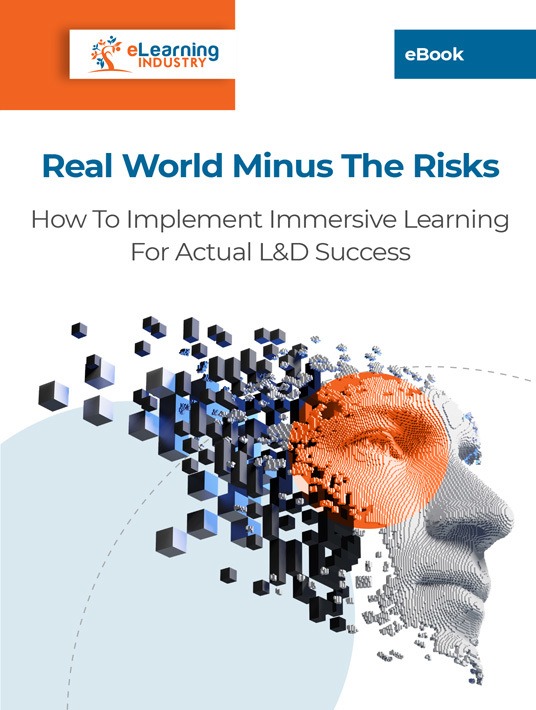7 VR Training Implementation Pitfalls
Immersive learning sounds simple enough. You put employees in the thick of things and let them devise a solution on their own. However, there are numerous pitfalls you must avoid when creating interactive online training resources. Some are merely mistakes while others involve popular misconceptions. All these can prevent employees from sinking into the online training experience and putting the information into context. Bear in mind that immersive learning is all about emotional connection. Online learners must feel like they’re part of the virtual environment to get maximum benefits. So, here are 7 VR training implementation errors and tips to steer clear of them.

1. Using The Wrong eLearning Authoring Tool
There are two eLearning authoring tool slip-ups to avoid when implementing immersive learning. The first is to choose an eLearning authoring tool that doesn’t align with your team’s skills or lacks the necessary features such as eLearning templates and themes. The second is to deploy an LMS that doesn’t support interactive online training content. For instance, you’re unable to track simulation or serious game performance. This is why it’s crucial to test out eLearning platforms based on the immersive learning use case. Ensure that you can create, upload, and monitor real-world activities that tie into on-the-job behaviors.
2. Not Repurposing Assets
A common misconception is that you must develop AR and VR online training resources from the ground up. In truth, you can repurpose assets to cut costs and streamline eLearning content creation. For example, incorporate charts, images, and sounds from JIT resources or online training courses to enrich your online training simulation. These assets improve immersion without going over budget. Plus, they already align with your brand image and online training aesthetic. So, look to your online training library for media you can reuse in your interactive eLearning activities to improve online training resource allocation.
3. Not Setting Measurable Goals
You have a general idea of where you’d like to take your immersive learning strategy. It needs to fill current gaps and cater to employees’ preferences. However, you need measurable goals to track effectiveness and improve ROI to monitor targeted online training data and hold employees accountable. For example, every employee training participant must score a minimum of 90% on the simulation to move on to the next level. This score is comprised of skills application, customer engagement, and company policy knowledge. They must touch on all the key points (i.e., behaviors and steps) to achieve the desired outcome.
4. eLearning Content That Isn’t Relevant Or Relatable
Every member of your organization should connect with some elements of the virtual training experience. It should resonate with them and relate to their job duties or challenges. Or it might help them identify certain aspects of their performance that are lacking. The point is that VR training must allow them to assign meaning and apply what they’ve learned in different contexts. Practical contexts that translate into better on-the-job performance, productivity, and proficiency levels. For example, the VR simulation involves a sales pitch, but each employee chooses their technique. They must use their skills and product knowledge. However, how they approach the customer and showcase the selling points is up to them. Free will and freedom of choice are key to immersion.
5. Choosing The Wrong Immersive Approach
There are many ways to accomplish immersive learning goals. You might rely on video demos with interactive elements. Or VR scenarios that involve headsets. The secret to success is to choose the right approach for your online training outcomes and employee needs. AR training is more convenient and still maintains that real-world connection. In that, employee training participants don’t have to wear headsets and can still interact with peers and customers. On the other hand, VR training reduces external distractions and provides a more tactile online training experience. Then there’s the issue of the delivery method. Which interactive eLearning activities will you use to convey the takeaways? This can range from serious games and demo videos to online training tutorials and task simulations. Conduct a TNA to determine what’s missing from your current online training strategy and how to achieve the online training objectives cost-effectively.
6. No Budget Or Timeline
Since we’re on the subject of cost, it’s also essential to create an accurate budget and immersive learning implementation timeline. How much can you allocate for virtual training devices, software, and payroll? How much time will it take to develop online training resources and launch your VR or AR training program? Of course, this involves several tasks and team members to achieve. For example, eLearning content creators must develop simulations and serious games that involve multiple steps. Break it down into the most basic elements and processes, determine which online training resources are required, and set a schedule for every milestone. Then evaluate that timeline periodically to see if things are still on track or you need to adjust.
7. Not Getting eLearning Feedback
Immersive learning implementation involves every member of the team. Even employee training participants who don’t have any hand in the backend development or admin duties. Frontend users are a valuable source of eLearning feedback because they must utilize online training resources for experiential learning to build skills and bridge gaps, as well as receive the JIT support they need to improve work practices. If online training content falls short, they’re the ones who suffer. So, gather their eLearning feedback to identify areas for improvement and revise your AR/VR assets.
The most grievous error you can make is ruling out immersive learning altogether. Thinking it’s out of your budget or that your staff size is too small to implement a VR/AR online training strategy. Every organization can benefit from interactive online training tools that bring employees into the online training experience. It’s simply a matter of starting small and using what you already have to reduce spending, as well as reevaluating your current approach to see where immersive learning fits into your online training strategy.
A Mixed Reality training strategy doesn’t have to drain your organization’s resources or make you go over budget. Download the eBook Real World Minus The Risks: How To Implement Immersive Learning For Actual L&D Success, and discover how you can benefit from incorporating immersive learning into your online training program. Provide an engaging training experience and boost your employees’ confidence with a Mixed Reality training solution.








